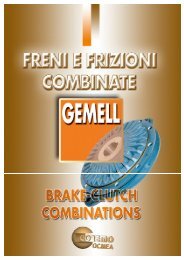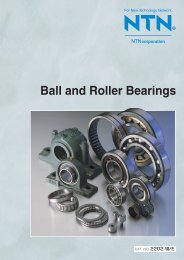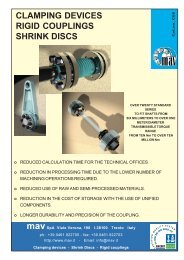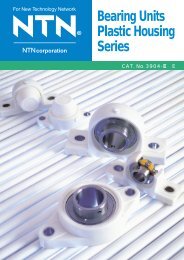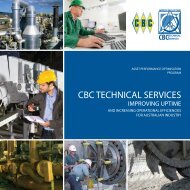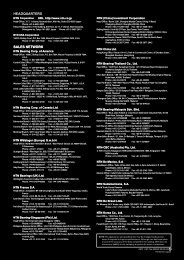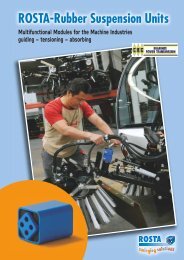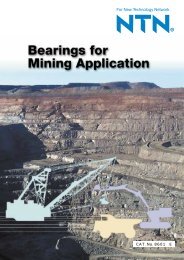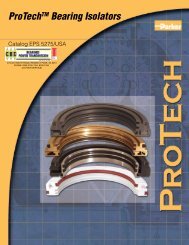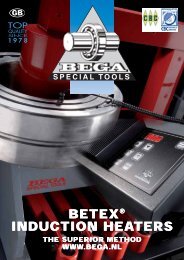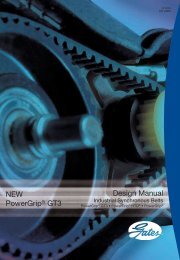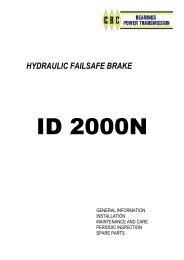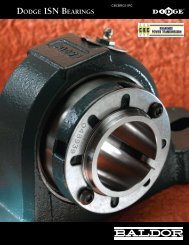- Page 1 and 2:
For New Technology Network R corpor
- Page 3 and 4:
Technical Data A-001058 Needle roll
- Page 5 and 6:
Needle Roller Bearings
- Page 7 and 8:
DIMENSIONAL DATA CONTENTS Needle Ro
- Page 9 and 10:
Classification and Characteristics
- Page 11 and 12:
Classification and Characteristics
- Page 13 and 14:
Classification and Characteristics
- Page 15 and 16:
Classification and Characteristics
- Page 17 and 18:
Classification and Characteristics
- Page 19 and 20:
Load Rating and Life NTN Table 2.1
- Page 21 and 22:
Load Rating and Life NTN When the o
- Page 23 and 24:
Load Rating and Life NTN 2.10 Radia
- Page 25 and 26:
Calculation of Bearing Loads NTN (2
- Page 27 and 28:
Calculation of Bearing Loads NTN 3.
- Page 29 and 30:
Bearing Accuracy NTN 4. Bearing Acc
- Page 31 and 32:
A-27 Bearing Accuracy NTN 7 7 8 8 8
- Page 33 and 34:
Bearing Accuracy NTN Table 4.5 Allo
- Page 35 and 36:
Bearing Internal Clearance NTN 5.2.
- Page 37 and 38:
Bearing Fits NTN 6.4 Recommended Fi
- Page 39 and 40:
Bearing Fits NTN 6.5 Interference C
- Page 41 and 42:
Shaft Bearing and Fits Housing Desi
- Page 43 and 44:
Shaft Bearing and Fits Housing Desi
- Page 45 and 46:
Lubrication NTN Table 8.2 Grease va
- Page 47 and 48:
Lubrication NTN (4) Circulating lub
- Page 49 and 50:
Sealing Devices NTN 9. Sealing Devi
- Page 51 and 52:
Sealing Devices NTN 9.2 Combined se
- Page 53 and 54:
Bearing Handling NTN 10. Bearing Ha
- Page 55 and 56:
Bearing Handling NTN the bearing fi
- Page 57 and 58:
Technical Data NTN 11.2 Bearings wi
- Page 59 and 60:
Technical Data NTN expressed in the
- Page 61 and 62:
Bearing Type Symbols and Auxiliary
- Page 63 and 64:
Needle roller and cage assemblies B
- Page 65 and 66:
Needle Roller and Cage Assemblies
- Page 67 and 68:
Needle roller and cage assemblies N
- Page 69 and 70:
Needle roller and cage assemblies N
- Page 71 and 72:
Needle roller and cage assemblies N
- Page 73 and 74:
Needle roller and cage assemblies N
- Page 75 and 76:
Needle roller and cage assemblies N
- Page 77 and 78:
Needle roller and cage assemblies N
- Page 79 and 80:
Needle roller and cage assemblies N
- Page 81 and 82:
Cage and roller type needle roller
- Page 83 and 84:
Needle Roller and Cage Assemblies f
- Page 85 and 86:
Needle roller and cage assemblies f
- Page 87 and 88:
Needle roller and cage assemblies f
- Page 89 and 90:
Needle roller and cage assemblies f
- Page 91 and 92:
Drawn Cup Needle Roller Bearings
- Page 93 and 94:
Drawn cup needle roller bearings NT
- Page 95 and 96:
Drawn cup needle roller bearings NT
- Page 97 and 98:
Drawn cup needle roller bearings NT
- Page 99 and 100:
Drawn cup needle roller bearings NT
- Page 101 and 102:
Drawn cup needle roller bearings NT
- Page 103 and 104:
Drawn cup needle roller bearings NT
- Page 105 and 106:
Drawn cup needle roller bearings NT
- Page 107 and 108:
Drawn cup needle roller bearings se
- Page 109 and 110:
Drawn cup needle roller bearings se
- Page 111 and 112:
Drawn cup needle roller bearings NT
- Page 113 and 114:
Drawn cup needle roller bearings NT
- Page 115 and 116:
Machined Ring Needle Roller Bearing
- Page 117 and 118:
Machined ring needle roller bearing
- Page 119 and 120:
Machined ring needle roller bearing
- Page 121 and 122:
Machined-ring needle roller bearing
- Page 123 and 124:
Machined-ring needle roller bearing
- Page 125 and 126:
Machined-ring needle roller bearing
- Page 127 and 128:
Machined-ring needle roller bearing
- Page 129 and 130:
Machined-ring needle roller bearing
- Page 131 and 132:
Machined-ring needle roller bearing
- Page 133 and 134:
Machined-ring needle roller bearing
- Page 135 and 136:
Machined-ring needle roller bearing
- Page 137 and 138:
Machined-ring needle roller bearing
- Page 139 and 140:
Machined-ring needle roller bearing
- Page 141 and 142:
Machined-ring needle roller bearing
- Page 143 and 144:
Machined-ring needle roller bearing
- Page 145 and 146:
Machined-ring needle roller bearing
- Page 147 and 148:
Machined-ring needle roller bearing
- Page 149 and 150:
Machined-ring needle roller bearing
- Page 151 and 152:
Machined-ring needle roller bearing
- Page 153 and 154:
Machined-ring needle roller bearing
- Page 155 and 156:
Machined-ring needle roller bearing
- Page 157 and 158:
Machined-ring needle roller bearing
- Page 159 and 160:
Machined Ring Needle Roller Bearing
- Page 161 and 162:
Machined ring needle roller bearing
- Page 163 and 164:
Machined ring needle roller bearing
- Page 165 and 166:
Machined ring needle roller bearing
- Page 167 and 168:
Machined ring needle roller bearing
- Page 169 and 170:
Machined ring needle roller bearing
- Page 171 and 172:
Machined ring needle roller bearing
- Page 173 and 174:
Machined ring needle roller bearing
- Page 175 and 176:
Machined ring needle roller bearing
- Page 177 and 178:
Inner Rings
- Page 179 and 180:
Inner rings NTN Type IR d 510mm Bou
- Page 181 and 182:
Inner rings NTN d 1520mm Boundary d
- Page 183 and 184:
Inner rings NTN d 2835mm Boundary d
- Page 185 and 186:
Inner rings NTN d 4555mm Boundary d
- Page 187 and 188:
Inner rings NTN d 80100mm Boundary
- Page 189 and 190:
Inner rings NTN d 170380mm Boundary
- Page 191 and 192:
Inner rings NTN Inch series Type MI
- Page 193 and 194:
Inner rings NTN d 101.600203.200mm
- Page 195 and 196:
Adjustable-Clearance Needle Roller
- Page 197 and 198:
Clearance-adjustable needle roller
- Page 199 and 200:
Clearance-adjustable needle roller
- Page 201 and 202:
Complex Bearings
- Page 203 and 204:
Complex bearings NTN Bearing compon
- Page 205 and 206:
Complex bearings NTN B-143
- Page 207 and 208:
Needle roller bearings with thrust
- Page 209 and 210:
Needle roller bearings with thrust
- Page 211 and 212:
Needle roller bearings with thrust
- Page 213 and 214:
Needle roller bearings with thrust
- Page 215 and 216:
Needle roller bearings with angular
- Page 217 and 218:
Needle roller bearings with three-p
- Page 219 and 220:
Needle roller bearings with double-
- Page 221 and 222:
Needle roller bearings with double-
- Page 223 and 224:
Roller Followers / Cam Followers
- Page 225 and 226:
Roller followers: Yoke-type track r
- Page 227 and 228:
Roller followers: Yoke-type track r
- Page 229 and 230:
Roller followers : Yoke type truck
- Page 231 and 232:
Roller followers: Yoke-type track r
- Page 233 and 234:
Roller followers: Yoke-type track r
- Page 235 and 236:
Roller followers: Yoke-type track r
- Page 237 and 238:
Cam followers stud type truck rolle
- Page 239 and 240:
Cam followers stud type truck rolle
- Page 241 and 242:
Cam followers stud type truck rolle
- Page 243 and 244:
Cam followers stud type truck rolle
- Page 245 and 246:
Cam followers stud type truck rolle
- Page 247 and 248:
Cam followers stud type truck rolle
- Page 249 and 250:
Cam followers stud type truck rolle
- Page 251 and 252:
Cam followers stud type truck rolle
- Page 253 and 254:
Cam followers stud type truck rolle
- Page 255 and 256:
Cam followers stud type truck rolle
- Page 257 and 258:
Cam followers stud type truck rolle
- Page 259 and 260: Cam followers stud type truck rolle
- Page 261 and 262: Cam followers stud type truck rolle
- Page 263 and 264: Cam followers stud type truck rolle
- Page 265 and 266: Cam followers stud type truck rolle
- Page 267 and 268: Thrust Roller Bearings
- Page 269 and 270: Thrust roller bearings NTN Bearing
- Page 271 and 272: Thrust roller bearings NTN B-209
- Page 273 and 274: Thrust needle roller bearings NTN B
- Page 275 and 276: Thrust needle roller bearings NTN B
- Page 277 and 278: Thrust cylindrical roller bearing N
- Page 279 and 280: Thrust cylindrical roller bearing N
- Page 281 and 282: Thrust cylindrical roller bearing N
- Page 283 and 284: COMPONENTS Needle Rollers/Snap Ring
- Page 285 and 286: Needle rollers NTN Application of n
- Page 287 and 288: Needle rollers NTN DW 4.55mm Bounda
- Page 289 and 290: Snap rings NTN For shaft Type WR Be
- Page 291 and 292: Snap rings NTN For housing Type BR
- Page 293 and 294: Snap rings NTN Bearing numbers Boun
- Page 295 and 296: Seals NTN Type G Type GD Type G Typ
- Page 297 and 298: LINEAR BALL BEARINGS: Solid, Drawn
- Page 299 and 300: Linear Ball Bearings NTN Components
- Page 301 and 302: Linear Ball Bearings NTN Components
- Page 303 and 304: Solid type linear ball bearings NTN
- Page 305 and 306: Machined cup linear ball bearings N
- Page 307 and 308: Linear ball bearings, stroke type N
- Page 309: Machined ring linear ball bearings
- Page 313 and 314: Linear flat rollers NTN Type BF Typ
- Page 315 and 316: Linear roller bearings NTN Type RLM
- Page 317 and 318: One-way Clutches Tension Pulleys, B
- Page 319 and 320: One-way clutches NTN Shaft and hous
- Page 321 and 322: One-way clutch miniature type NTN T
- Page 323 and 324: Bottom roller bearings NTN Type FRI
- Page 325 and 326: Bottom roller bearings NTN Type FRI
- Page 327 and 328: Tensioner pulleys for textile machi
- Page 329 and 330: Contents of Appendix Approximate co
- Page 331 and 332: Appendix NTN ˚C-˚F temperature co
- Page 333 and 334: C-5 Appendix NTN Standard ball Hult
- Page 335 and 336: Appendix NTN Unit system Quantity P
- Page 337 and 338: Appendix NTN Viscosity conversion t
- Page 339 and 340: Appendix NTN Ordinary tolerance for
- Page 341 and 342: Appendix NTN Ordinary tolerance for
- Page 343 and 344: Appendix NTN Ordinary tolerance for
- Page 345 and 346: Appendix NTN High Low Hig
- Page 347 and 348: Appendix NTN H7 H8 H9 H10 H11 H13 J




